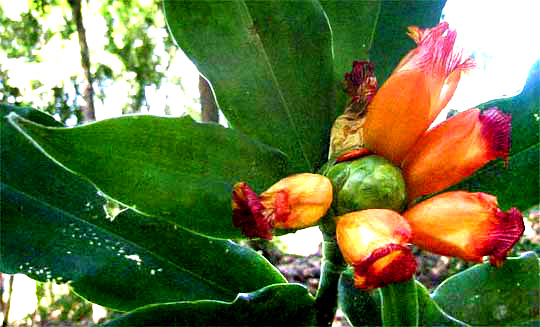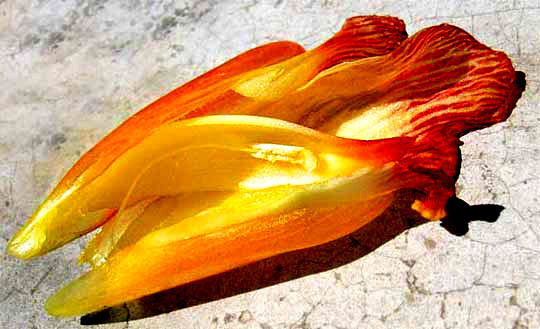Excerpts from Jim Conrad's
Naturalist Newsletter
from the April 7, 2008 Newsletter written in the community of 28 de Junio, in the Central Valley 8 kms west of Pujiltic, elev. ~700m (2300ft), ~N16.331°, ~W92.472°; southeastern Chiapas state, MÉXICO
A WILD GINGER
In deep shade at the muddy edge of one of our little cascades' carbonate-rimmed pools there's a five-ft- tall herbaceous plant flowering. You can see its 1.5- inch-long flowers arising from a conelike structure below:

The plant and flowers are reminiscent of those found among the closely related cannas, but the species belongs to a completely different family, the Ginger Family, or Zingiberaceae. I think it's in the genus COSTUS*. The Ginger Family also is the home of Zingiber officinale, whose pungent rhizomes add such flavor to some of our foods. You can see a broken-open flower below:

In the center of the above picture you can see a frankfurter-shaped object at the end of a long, slender "stem." The stem is a stamen's filament and the frankfurter is the stamen's pollen-producing anther. The anther's grainy texture is provided by pollen. Unlike the vast majority of other flowers, this blossom just has this single stamen. That, and the fact that the anther is composed of two distinct cells separated by a small open space, are important features qualifying the plant as belonging to the Ginger Family. The closely related Canna and Maranta families produce anthers with only one cell.
Locally the plant is called Caña Cristo, "Christ's Cane." Any thick-stemmed, tall, slender plant is likely to be called a caña, and any plant with uncommonly pretty flowers probably has Cristo, Jesús, María or Virgen names affixed to it, so I almost could have guessed at this plant's local name.